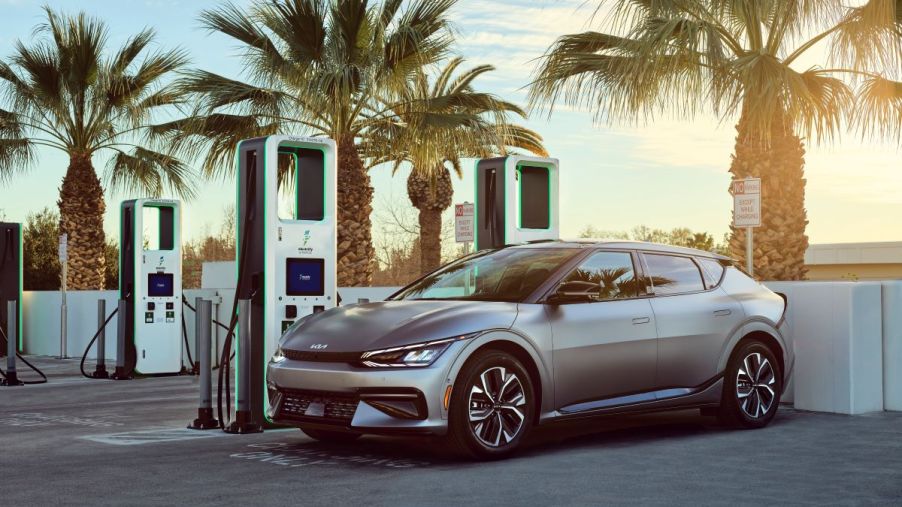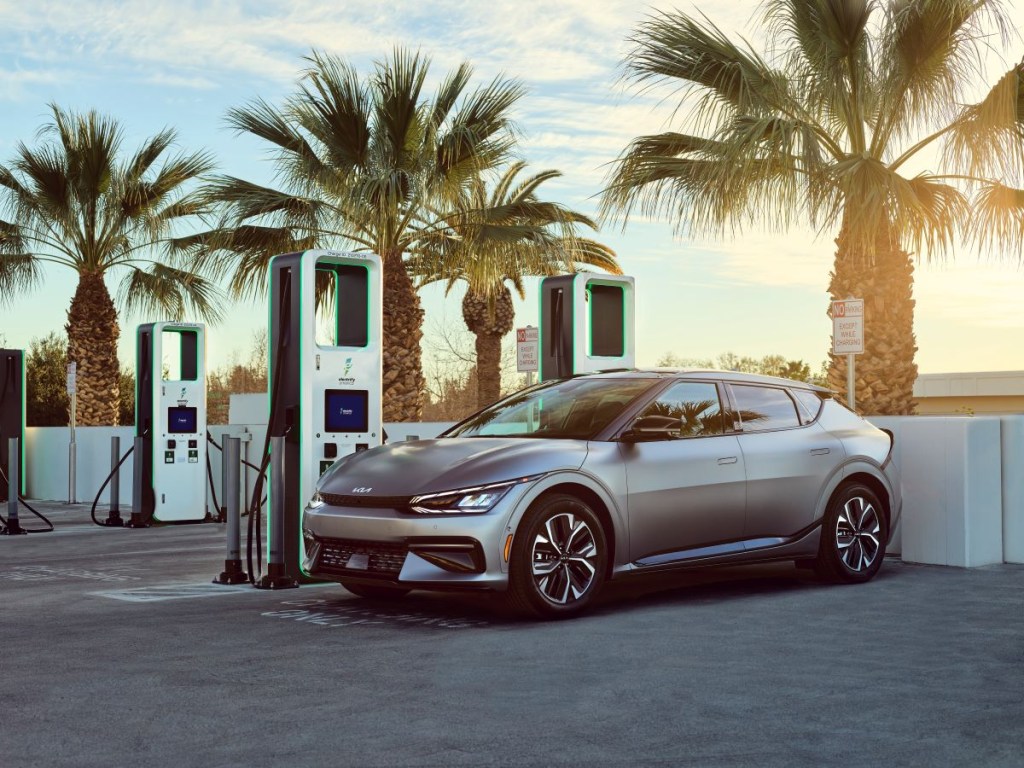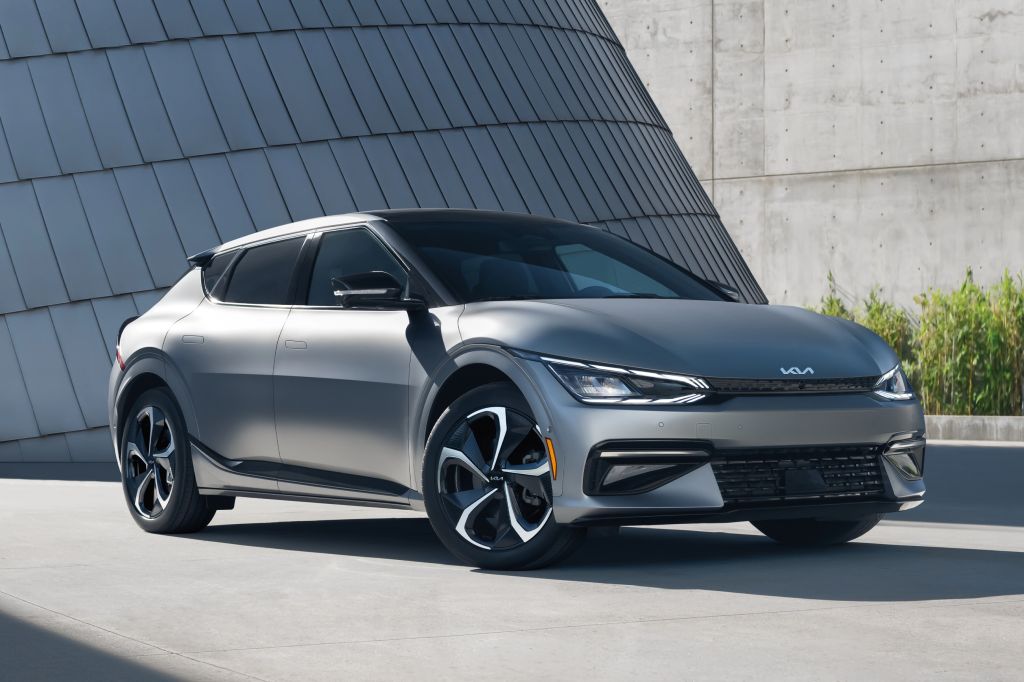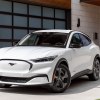
This Kia EV Makes a Mockery of BMW’s Equivalent Offering
It’s not often you’ll see a Kia get compared to a BMW. However, the car industry is evolving, and Kia leads the pack in many ways. Between Kia and its parent company Hyundai, the South Korean automotive supergiants produce some of the most affordable, dependable, and high-quality cars around. Kia is also spearheading the EV movement and doing it with some flair. So much so that BMW’s similar EV looks a bit underwhelming comparatively.
The Kia EV6 vs. the BMW i4: battle of the liftback EVs

Both the Kia EV6 and the BMW i4 are compact liftback sedans. Meaning the entire rear of the car lifts like a trunk, giving ample storage space. Though they share a lot of similarities, the Kia has quite a few legs up on the BMW. Let’s look at the details and see what might compel shoppers to spring for a “lowly” Kia over an iconic luxurious BMW.
First and foremost is the starting price. According to The Globe and Mail, the base price of the Kia EV6 is a fairly reasonable $44,995. It has four different trim levels and spans to around $60,000 at the top end. The BMW i4, however, has a starting price nearly $10,000 higher at $54,990. Additionally, stepping into the top-trim M50 model with options can easily coast past the $90,000 mark. However, it is worth noting that both vehicles qualify for the $5,000 EV federal rebate.
To keep a level playing field, the i4’s base price makes for a good comparison as the Kia EV6 AWD Long Range costs just $5 more than the base BMW. In contrast, the BMW offers a single 335-horsepower motor and rear-wheel drive. However, as the name might lead you to believe, the Kia price equivalent nets you two motors. One powers the front and the other the rears for an all-wheel drive configuration with a total power output of 320 horsepower.
The EV6 rear-wheel drive models claim up to about 310 miles of charge range, with the all-wheel drive variants dropping that number to 274 miles. The i4 claims a charge range of around 299 miles.
How fast can the Kia EV6 and BMW i4 charge?

The Kia has a maximum charge rate of 350 kilowatts, meaning that it can use the Electrify America’s super-fast chargers. On the other hand, the BMW has a charging cap of 250 kilowatts.
To put that in perspective, the Kia can charge from a 10 percent battery to 80 percent in just 18 minutes. To do the same in the BMW takes nearly twice as long at 31 minutes.
From a styling standpoint, the Kia EV6 has a low, angry grille and headlight profile. Moving along toward the car’s backside, it starts to take more of a small SUV’s shape, sharing a similar rear door/window configuration to the Hyundai Veloster.
The BMW, though, looks very, well, BMW. It adopted the massive kidney grilles first brought to production by the M4 and from there back pretty much retains on-brand BMW sedan styling.
Neither car is exceptionally roomy for backseat passengers. However, the EV6 does have a bit of an advantage in that the entire cabin has a flat floor. Whereas the BMW, inexplicably, still has a tunnel running down the middle for the driveshaft it doesn’t have. Otherwise, both interiors offer reasonably nice materials and a handy massive touchscreen infotainment system. However, if you want leather, be prepared to check a $1,450 option box on the BMW.
The EV6 offers a good bit more cargo space in the rear than the BMW, both when the seats are folded down and when they aren’t. The Kia’s seats-up cargo volume is over 50 percent larger than the BMW’s
The BMW must be faster, right?
If you go for the far more expensive M50 model, undoubtedly. However, for one that’s priced within the range of the EV6, we’ve got bad news for the BMW enthusiast. The Kia EV6 sprints to 60 miles per hour about half a second faster than the i4. Additionally, both vehicles have exceptional planted and balanced handling capabilities. Though, The Globe and Mail credit the BMW for being a bit better, which is to be expected.
Finally, the Kia takes the BMW out in terms of standard technology. To match the assisted-driving and safety features you’ll find on an EV6; you’ll need to spend $11,400 extra on the BMW.
Ultimately, the facts can fall where they are, and it’s safe to assume that folks who want a BMW will buy the BMW. However, if price and features are a primary concern, the Kia is undoubtedly the pick.



